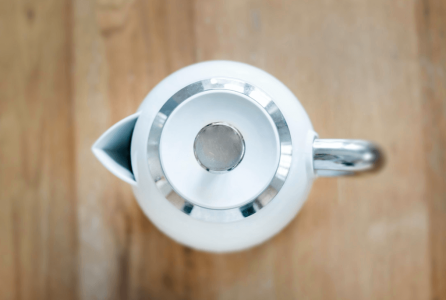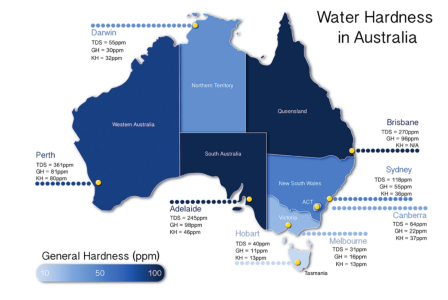Say goodbye to limescale buildup! This eco-friendly cleaning tip will make your kettle sparkle IN MINUTES
- Replies 8
Wake up and smell the coffee (or tea), folks! If your morning cuppa has been tasting a little off lately, it's time to look inside your trusty kettle.
That sneaky culprit? Limescale!
Yes, that buildup of minerals like calcium and magnesium carbonates can not only make your drinks taste bitter or metallic, but it can also make you feel like you're sipping on yesterday's leftovers.
But don't throw in the towel just yet! There's hope for your trusty kettle, and it's not as complicated as you think. With just a little elbow grease, you can clean that limescale buildup and have your kettle looking as good as new in no time.
So, put down that cup for a while and let's get to work!

Get ready to hear from the one and only Kate, the eco-warrior and mastermind behind the must-follow social media pages My Plastic Free Home and The Natural Living Shop. She's here to save the day (and your kettle) with her super simple, chemical-free solution to the bane of all tea and coffee lovers - limescale.
In a recent Instagram video, Kate shows us her secret to a sparkling kettle without any store-bought or harmful cleaning products.
With just a few natural ingredients like white vinegar, lemons, or citric acid (which you likely already have in your kitchen or can easily grab in the supermarket for cheap), you can wave goodbye to limescale and hello to a super shiny kettle that's ready for tea time.
'Here is a super simple way to descale your kettle. Do you ever get that limescale buildup in your kettle?' Kate says in the video.
'All I do is add some leftover lemons to the kettle and if you don't have enough lemons, vinegar does exactly the same job. Or you could even try citric acid.'
For those of you who prefer to use vinegar for this trick, Kate recommends using around one to two cups. If you're a lemon lover, grab one whole lemon (or two if they've already been squeezed) and chop it up before adding it to the kettle.
And for those who like to keep things simple with citric acid, a natural powerhouse found in citrus fruits or easily purchased in powder form, Kate suggests using one to two tablespoons of powder.
The secret to this cleaning hack? The acidity of lemons, citric acid, and vinegar combats the pesky calcium carbonate found in limescale, making it a breeze to dissolve.
Once you've added one of these ingredients, it's time to:
Now it's time to enjoy a delicious cup of tea or coffee in your newly refreshed kettle!

Prevention is key, and with this one simple tip, you can keep your kettle limescale-free!
After each use, be sure to empty out the kettle and give it a thorough rinse and dry. That's it! It's a small step that can make a big difference in preventing limescale buildup in your kettle.
And let's not forget, leaving water in the kettle after each use is like giving limescale an invitation to a party. So, if you've got hard water, it's best to empty it out and start fresh each time. With regular maintenance, you'll never have to worry about that bitter or metallic taste in your morning cuppa again!
In Australia, the water hardness varies depending on the location.
In general, hard water is more common compared to soft water. Hard water contains high levels of minerals such as calcium and magnesium, which can lead to limescale buildup in pipes, kettles, and appliances.
However, some areas, particularly in coastal regions, have a softer water supply. To determine the hardness of your water, you can have it tested by your local water authority or purchase a home water test kit.
Is hard water generally more harmful?
Hard water is water in its natural state that contains essential minerals such as magnesium and calcium, which some people believe may have cardiovascular benefits. However, there is no conclusive evidence to support these claims.
On the other hand, hard water can have a negative impact on skin and hair, leading to dryness and an itchy scalp when washing hair frequently. Additionally, the minerals in hard water can change the pH balance of the skin, making it more vulnerable to bacteria and infections, particularly for those with eczema.
For more information, check out this video below:
Credit: Seeker.
We hope you found our article on cleaning limescale buildup from your kettle useful! Limescale buildup can be an annoying problem, but with this simple and effective solution, you can have your kettle looking like new in no time.
We'd love to hear from you, folks! Do you have any other cleaning tips and tricks that you use to keep your appliances looking and functioning at their best? If so, we'd love to hear about them in the comments.
Sharing our knowledge and experiences can help us all to live more efficiently and keep our homes running smoothly. So, don't be shy, drop a comment and share your best cleaning tips and tricks with the rest of the SDC community!
That sneaky culprit? Limescale!
Yes, that buildup of minerals like calcium and magnesium carbonates can not only make your drinks taste bitter or metallic, but it can also make you feel like you're sipping on yesterday's leftovers.
But don't throw in the towel just yet! There's hope for your trusty kettle, and it's not as complicated as you think. With just a little elbow grease, you can clean that limescale buildup and have your kettle looking as good as new in no time.
So, put down that cup for a while and let's get to work!

Limescale buildup in your kettle can affect the taste and quality of your beverages. Credit: Pexels/Dominika Roseclay.
Get ready to hear from the one and only Kate, the eco-warrior and mastermind behind the must-follow social media pages My Plastic Free Home and The Natural Living Shop. She's here to save the day (and your kettle) with her super simple, chemical-free solution to the bane of all tea and coffee lovers - limescale.
In a recent Instagram video, Kate shows us her secret to a sparkling kettle without any store-bought or harmful cleaning products.
With just a few natural ingredients like white vinegar, lemons, or citric acid (which you likely already have in your kitchen or can easily grab in the supermarket for cheap), you can wave goodbye to limescale and hello to a super shiny kettle that's ready for tea time.
'Here is a super simple way to descale your kettle. Do you ever get that limescale buildup in your kettle?' Kate says in the video.
'All I do is add some leftover lemons to the kettle and if you don't have enough lemons, vinegar does exactly the same job. Or you could even try citric acid.'
For those of you who prefer to use vinegar for this trick, Kate recommends using around one to two cups. If you're a lemon lover, grab one whole lemon (or two if they've already been squeezed) and chop it up before adding it to the kettle.
And for those who like to keep things simple with citric acid, a natural powerhouse found in citrus fruits or easily purchased in powder form, Kate suggests using one to two tablespoons of powder.
The secret to this cleaning hack? The acidity of lemons, citric acid, and vinegar combats the pesky calcium carbonate found in limescale, making it a breeze to dissolve.
Once you've added one of these ingredients, it's time to:
- Fill your kettle with water and bring it to a boil
- Then let it cool down for 30 minutes
- Bring it to a boil again to finish the cleaning process
- Pour the contents out
Now it's time to enjoy a delicious cup of tea or coffee in your newly refreshed kettle!
Key Takeaways
- All-natural products such as white vinegar, lemons or citric acid are effective in tackling limescale in a kettle.
- The mild acidity of these natural products combats the alkaline calcium carbonate which makes up limescale.
- To make sure no scent or taste is left behind, it is recommended to refill the kettle with plain water after treating the limescale and boiling it one more time.
After each use, be sure to empty out the kettle and give it a thorough rinse and dry. That's it! It's a small step that can make a big difference in preventing limescale buildup in your kettle.
And let's not forget, leaving water in the kettle after each use is like giving limescale an invitation to a party. So, if you've got hard water, it's best to empty it out and start fresh each time. With regular maintenance, you'll never have to worry about that bitter or metallic taste in your morning cuppa again!
In Australia, the water hardness varies depending on the location.
In general, hard water is more common compared to soft water. Hard water contains high levels of minerals such as calcium and magnesium, which can lead to limescale buildup in pipes, kettles, and appliances.
However, some areas, particularly in coastal regions, have a softer water supply. To determine the hardness of your water, you can have it tested by your local water authority or purchase a home water test kit.
Is hard water generally more harmful?
Hard water is water in its natural state that contains essential minerals such as magnesium and calcium, which some people believe may have cardiovascular benefits. However, there is no conclusive evidence to support these claims.
On the other hand, hard water can have a negative impact on skin and hair, leading to dryness and an itchy scalp when washing hair frequently. Additionally, the minerals in hard water can change the pH balance of the skin, making it more vulnerable to bacteria and infections, particularly for those with eczema.
For more information, check out this video below:
Credit: Seeker.
We hope you found our article on cleaning limescale buildup from your kettle useful! Limescale buildup can be an annoying problem, but with this simple and effective solution, you can have your kettle looking like new in no time.
We'd love to hear from you, folks! Do you have any other cleaning tips and tricks that you use to keep your appliances looking and functioning at their best? If so, we'd love to hear about them in the comments.
Sharing our knowledge and experiences can help us all to live more efficiently and keep our homes running smoothly. So, don't be shy, drop a comment and share your best cleaning tips and tricks with the rest of the SDC community!








